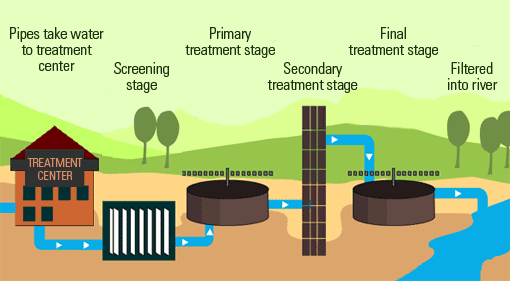Strategic Approaches to Enhance Drainage Treatment Efficiency and Decrease Ecological Impact
In the world of drainage therapy, the quest for boosted efficiency and decreased environmental effect is a continuous challenge that demands calculated remedies. As culture grapples with the important to handle water resources sustainably, a nuanced strategy ends up being crucial. The assimilation of advanced treatment modern technologies, energy-efficient procedures, source recovery techniques, enhanced nutrient removal strategies, and wise tracking and control systems represents a diverse structure for dealing with these pushing issues. What exists at the core of this facility internet of strategies is the potential to reinvent the method we come close to waste water therapy, not just as a procedure of disposal, yet as a valuable opportunity for innovation and environmental stewardship.
Advanced Therapy Technologies
Innovative membrane filtering systems have transformed advanced wastewater therapy procedures, considerably enhancing the elimination of pollutants. These innovative systems function forcibly water through a semi-permeable membrane, efficiently dividing pollutants from the water stream. The membrane's microscopic pores trap contaminants such as bacteria, infections, and suspended solids, permitting only cleansed water to pass through. This innovation has actually confirmed to be highly reliable in removing a large array of pollutants, consisting of drugs, hefty metals, and natural compounds, which are commonly testing to get rid of via conventional therapy techniques.
Additionally, membrane layer filtration systems supply countless benefits over standard treatment techniques. In addition, these systems are extremely versatile and can be conveniently incorporated into existing therapy plants or made use of as standalone units for decentralized applications.
Energy-Efficient Processes
The integration of energy-efficient processes in wastewater treatment systems is crucial for enhancing resource utilization and decreasing operational prices. One vital strategy to boosting power effectiveness in wastewater therapy is the use of sophisticated aeration systems, such as fine bubble diffusers or surface area aerators, which can enhance oxygen transfer performance and lower power intake.
Additionally, optimizing procedure control and automation with using sophisticated sensing units and checking systems can boost general power effectiveness by readjusting procedures in real-time based on real demand and problems. Applying power audits and routinely checking energy performance signs are essential practices to determine areas for improvement and track energy-saving initiatives efficiently. On the whole, the adoption of energy-efficient procedures in wastewater therapy not only profits the setting but also adds to lasting expense financial savings and functional sustainability.
Source Recovery Techniques
With a focus on enhancing source application and sustainability in wastewater therapy systems, the execution of source recovery strategies becomes a critical aspect in improving operational effectiveness. Resource recuperation techniques in wastewater therapy involve the recognition and extraction of valuable resources from the waste stream, consequently turning what was once thought about waste right into a beneficial possession. By applying source recuperation techniques such as nutrient removal and recovery, power generation from raw material, and the manufacturing of multiple-use water, wastewater treatment plants can minimize ecological influence while making the most of performance.

Improved Nutrient Elimination Methods
Applying innovative nutrient elimination methods is important for optimizing the performance of wastewater therapy systems. Improved nutrient removal plays a critical function in lessening the ecological impact of treated effluent discharged into water bodies. Among the vital techniques utilized for improved nutrient elimination is the procedure of organic nutrient removal (BNR), which involves the elimination of nitrogen and phosphorus via biological processes. This can be accomplished through the use of specialized microorganisms that can transform nitrogen compounds right into inert nitrogen gas with denitrification, and accumulate phosphorus within their cells through a process called improved biological phosphorus elimination (EBPR)

Along with BNR, progressed therapy methods such as membrane layer visit site bioreactors (MBRs) and created marshes can also be used to improve nutrient removal performance. MBRs use membranes to accomplish top quality effluent standards by properly getting rid of nutrients and suspended solids. Created wetlands mimic all-natural marsh procedures to eliminate nutrients with plant uptake, microbial task, and sedimentation. By integrating these advanced nutrient elimination techniques right into wastewater treatment towns, systems and sectors can effectively reduce nutrient pollution and safeguard the setting.
Smart Monitoring and Control Systems
Utilizing cutting-edge technology, the assimilation of smart surveillance and control systems revolutionizes the functional effectiveness of wastewater therapy facilities. These systems integrate advanced sensors and data analytics to continuously keep an eye on essential specifications such as pH levels, turbidity, dissolved oxygen, and flow rates in real-time. By collecting and examining this data, operators can get important insights right into the efficiency of the therapy processes, allowing positive changes to maximize treatment efficiency.
Smart surveillance and control systems additionally support remote tracking capabilities, enabling drivers to gain access to real-time information and control features from off-site locations. This remote availability boosts functional flexibility and responsiveness, allowing speedy interventions in instance of system malfunctions or fluctuations in influent high quality. The anticipating upkeep capacities of these systems aid stop tools failings and reduce downtime, inevitably boosting the overall reliability of wastewater therapy procedures.
Verdict
In final thought, strategic approaches such as innovative treatment innovations, energy-efficient procedures, visite site source healing approaches, improved nutrient elimination strategies, and clever surveillance and control systems play a critical duty in boosting wastewater therapy efficiency and minimizing ecological effect. By applying these methods, wastewater treatment plants can boost their general performance, lower power intake, recover important sources, and ensure conformity with environmental laws. These strategies are important for reliable and lasting wastewater management methods.

In conclusion, tactical techniques such as advanced therapy modern technologies, energy-efficient processes, resource healing techniques, improved nutrient removal strategies, and wise tracking and control systems play a critical role in improving wastewater therapy effectiveness and decreasing environmental influence.